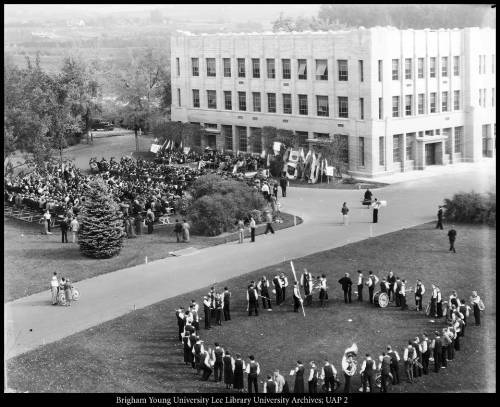George H. Brimhall Building
Built in 1919

George H. Brimhall: Where We Began (1919)
The George H. Brimhall Building, one of the oldest structures on Brigham Young University’s campus, is a living reflection of the university’s evolving mission and enduring values. Originally constructed in 1918 as the Mechanic Arts Building, it was created in response to the passage of the Smith-Hughes Act, a federal program that funded vocational training in agriculture, trades, and industry. BYU administrators, eager to expand technical education but constrained by tight finances, seized the opportunity. Construction began on October 8, 1918, and the building briefly housed soldiers from the Army Training Corps during World War I before transitioning into a space for classes in woodworking, ironworking, and auto mechanics.
As BYU’s academic offerings and enrollment grew, so did the need for space. By the early 1930s, the original single-story structure could no longer meet demand. Plans were made to expand it vertically, and by 1935, two new stories were added. Architects sought to retain the building’s original style while incorporating modern elements. That same year, in honor of recently deceased former university president George H. Brimhall, the building was renamed. Brimhall, an early graduate of Brigham Young Academy, led the university from 1904 to 1921 and guided it through times of financial difficulty and institutional uncertainty, leaving a legacy of perseverance and educational advancement.
In the years that followed, the Brimhall Building became a flexible academic space, housing a wide array of departments, including Chemistry, Zoology, Bacteriology, Botany, Visual Arts, and more, often serving as a temporary home for programs as other campus buildings were torn down or rebuilt. It became a fixture of BYU’s landscape, not for its permanence in purpose, but for its reliability in a constantly shifting campus environment. A major renovation in 1984 modernized the interior and preserved the historic integrity of the building, ensuring its continued use.

George H. Brimhall: Where We Are Now
Though the George H. Brimhall Building is the second oldest on BYU’s campus and offers a glimpse into the past, the college it houses is firmly focused on the future of communication.
The BYU School of Communications is home to the Daily Universe, the BYU AdLab, and Y News, all hands-on labs that give students real-world experience in journalism, advertising, and media production. In fact, College Magazine ranked BYU’s advertising program #1 in the nation in 2019.
The school is also ACEJMC accredited, a distinction shared by only 11 programs in religiously affiliated universities nationwide, underscoring its academic rigor and professional excellence. Its mission reflects this unique blend of purpose and professionalism: “We at the BYU School of Communications are a consecrated community of disciples, scholars, and mentors who strive to walk in the meekness of Christ’s spirit, as we inspire learning through love, faith, and service that prepares each child of God to share light and hope with the world.”